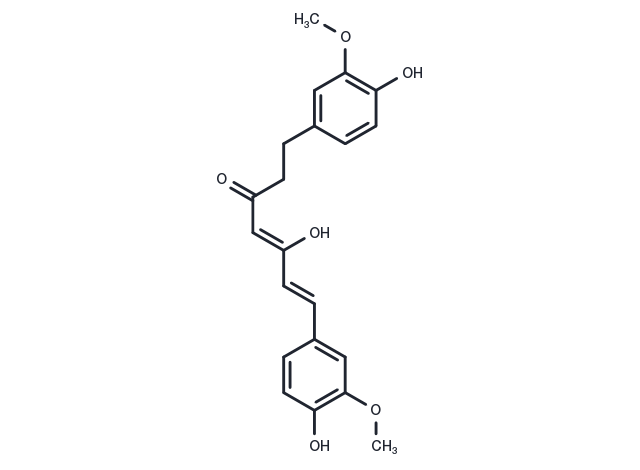store at low temperature
Powder: -20°C for 3 years | In solvent: -80°C for 1 year

Dihydrocurcumin is the main metabolite of curcumin, which can reduce fat accumulation and oxidative stress response. Dihydrocurcumin can regulate the mRNA and protein expression levels of SREBP-1C, PNPLA3 and PPARα, increase the protein expression levels of pAKT and PI3K, and reduce the intracellular NO and ROS contents through Nrf2 signaling pathway.

| Pack Size | Availability | Price/USD | Quantity |
|---|---|---|---|
| 1 mg | In stock | $ 128.00 | |
| 5 mg | In stock | $ 297.00 | |
| 10 mg | In stock | $ 472.00 | |
| 25 mg | In stock | $ 758.00 | |
| 50 mg | In stock | Inquiry |

| Description | Dihydrocurcumin is the main metabolite of curcumin, which can reduce fat accumulation and oxidative stress response. Dihydrocurcumin can regulate the mRNA and protein expression levels of SREBP-1C, PNPLA3 and PPARα, increase the protein expression levels of pAKT and PI3K, and reduce the intracellular NO and ROS contents through Nrf2 signaling pathway. |
| In vitro | Colon bacteria may mediate the transformation of curcumin, but this metabolism has not been well studied. Methods AND RESULTS: The metabolism of curcumin to Escherichia Ferguson (ATCC 35469) and two strains of Escherichia coli (ATCC 8739 and DH10B) was studied in modified colonic bacteria (mMCB) medium of porcine cecal fluid with or without medication. LC-MS analysis showed that after fermentation for 36 h, the conversion rate of curcumin was 16-37%, the conversion rate of demethoxycurcumin (DMC) was 6-16%, the conversion rate of dimethoxycurcumin (bi-DMC) was 7-15%, and the conversion rate of dimethoxycurcumin (bi-DMC) was 7-15%. The amount of curcumin degradation varies with different strains and medium. Three metabolites (dihydrocurcumin (DHC), tetrahydrocurcumin (THC) and ferulic acid (FA)) were identified in the fermentation culture of all strains. In addition, a compound of m/z [M-H](-) 470 was found and identified as curcumin-adduct (curcumin-L-cysteine) by precise mass FT-ICR-MS. Conclusion: This study provides a new scheme for the bacterial metabolism of curcumin[1]. |
| Molecular Weight | 370.4 |
| Formula | C21H22O6 |
| CAS No. | 76474-56-1 |
store at low temperature
Powder: -20°C for 3 years | In solvent: -80°C for 1 year
DMSO: 22.5 mg/mL (60.7 mM), Sonication and heating to 60℃ are recommended.
You can also refer to dose conversion for different animals. More
bottom
Please see Inhibitor Handling Instructions for more frequently ask questions. Topics include: how to prepare stock solutions, how to store products, and cautions on cell-based assays & animal experiments, etc.
Dihydrocurcumin 76474-56-1 DNA Damage/DNA Repair Metabolism Fatty Acid Synthase PPAR inhibitor inhibit
